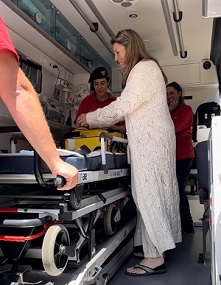
EMS World
Pedi-Ed-Trics: A Mission
to Improve Pediatric Care


Pedi-Ed-Trics: A Mission
to Improve Pediatric Care
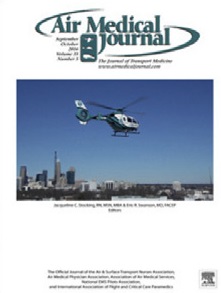
To Tube or Not to Tube
That Continues to Be the Question
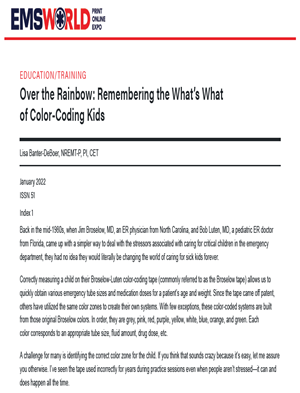
Over the Rainbow
Remembering the What’s What of Color-Coding Kids
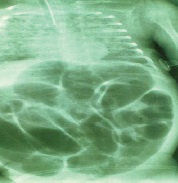
Troubles with Tiny Tubes? Try Dopes
When a child being ventilated has problems, this mnemonic may help

Body Art: What EMS Needs to Know
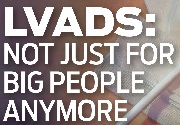
Kids now have these circulation devices too
Here's what to Know
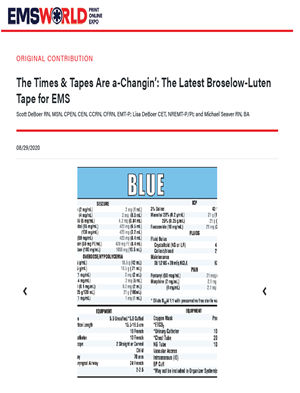
The Times + Tapes Are a-Changin
The Latest Broselow-LutenTape for EMS
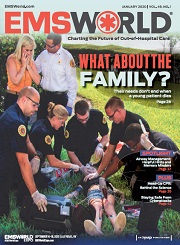
Airway Management: Helpful Hints and Memory Minders
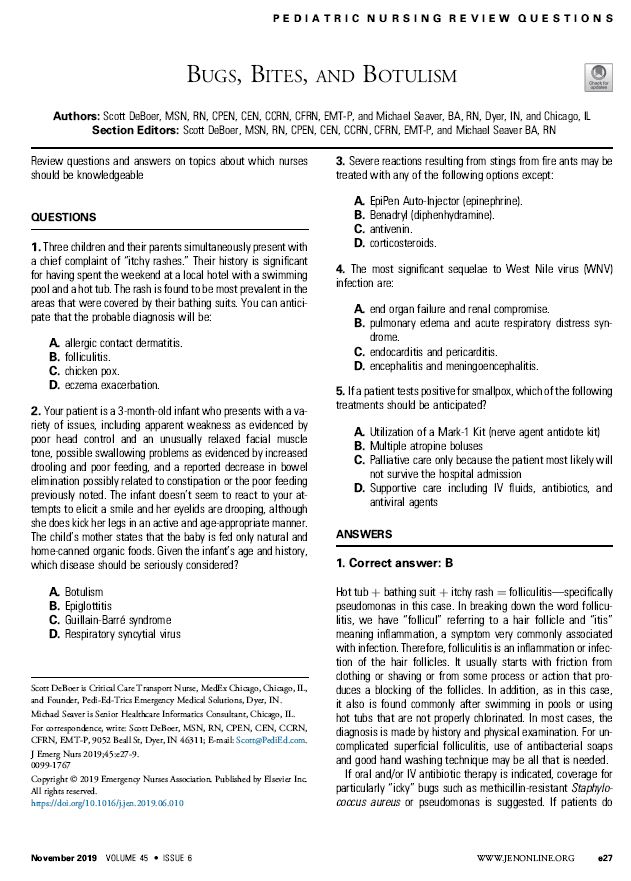
Bugs, Bites. And Botulism
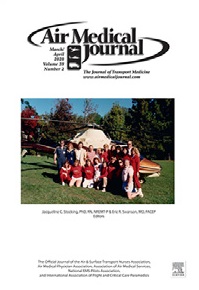
Intraosseous Insights
Tips and Tricks

Child Maltreatment
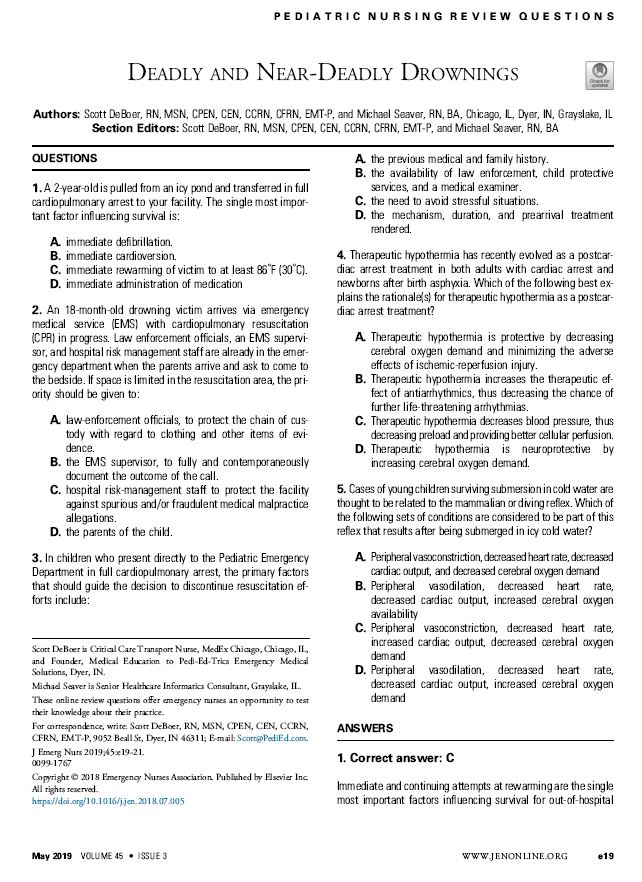
Deadly And Near-Deadly
Drownings

A Tale of Two Tapes
Broselow-Luten Tapes, 2011 vs. 2017
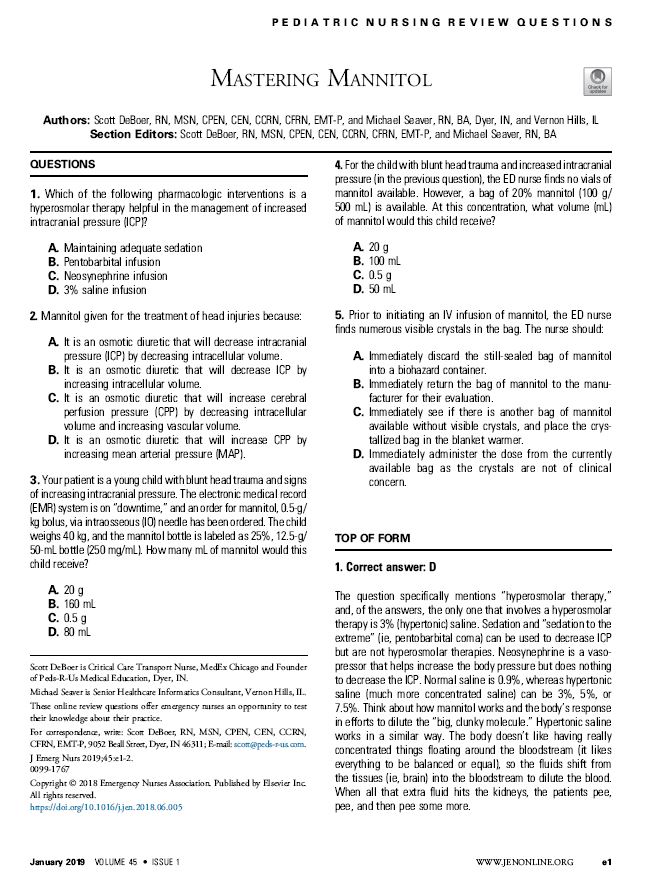
Mastering Mannitol
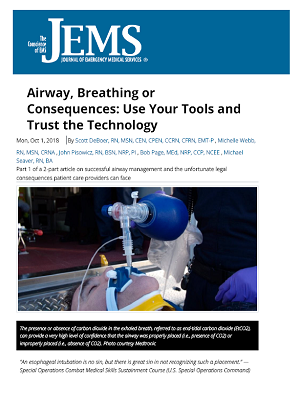
Use Your Tools and Trust the Technology
Successful airway management and the unfortunate legal consequences patient care providers can face
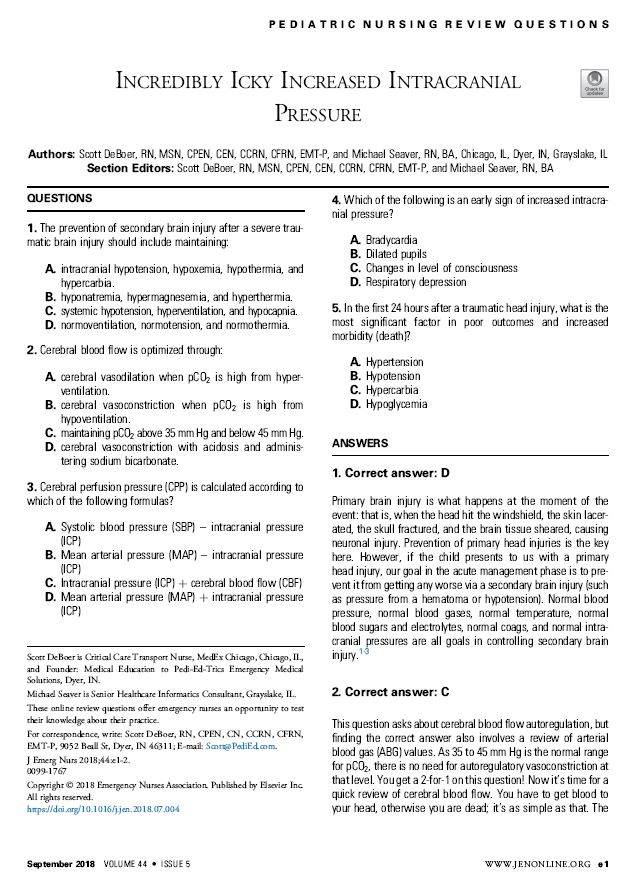
Incredibly Icky Increased
Intracranial Pressure

Bad Bellies III
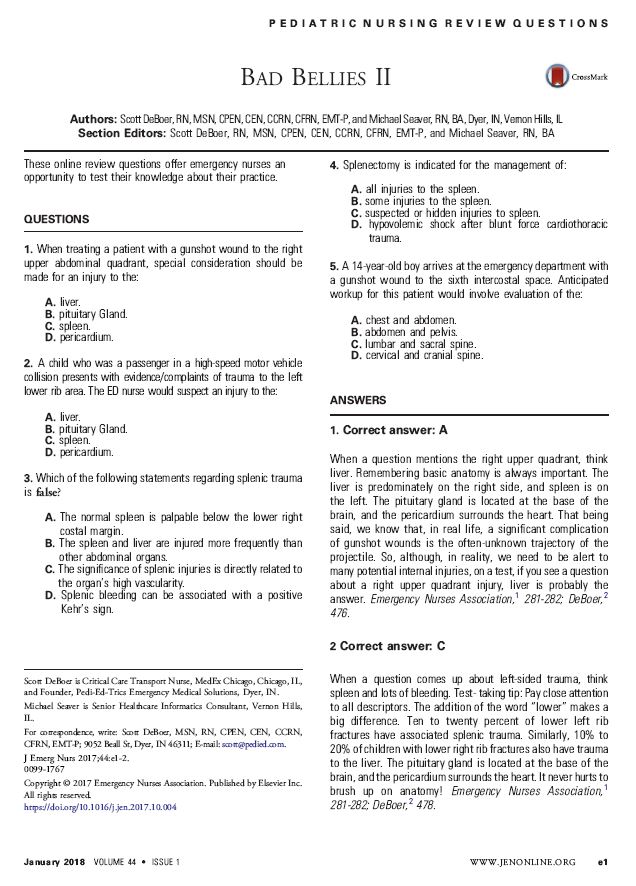
Bad Bellies II

The Evolution of Excellence in Pediatric Emergency Care
The ‘Pit Crew’ Approach to Pediatric Resuscitation

PEDIATRIC ALTERNATIVE AIRWAYS:
WHAT YOU NEED TO KNOW AND WHERE TO FIND IT.
The first of a two-part series looks at colors, cuffs, and CO2.
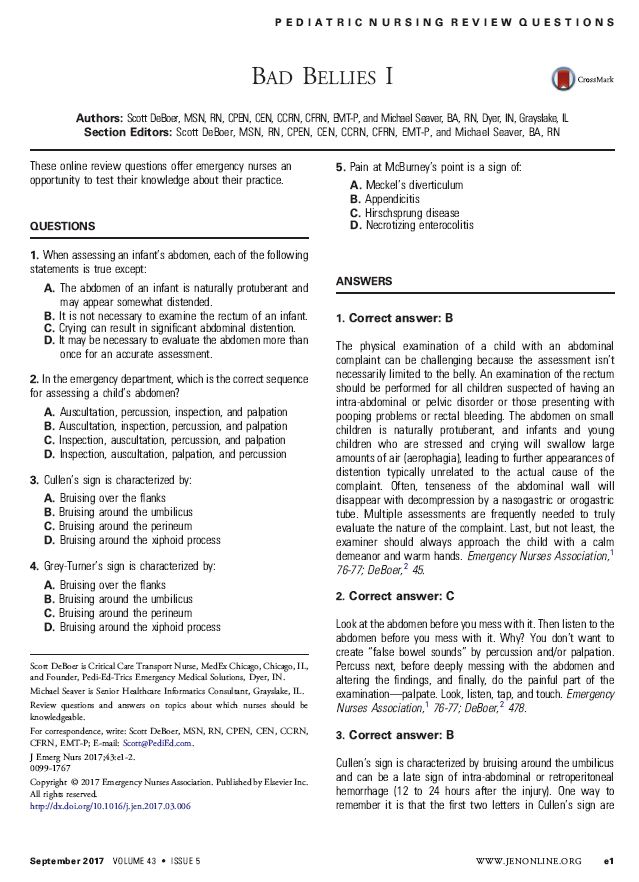
Bad Bellies I
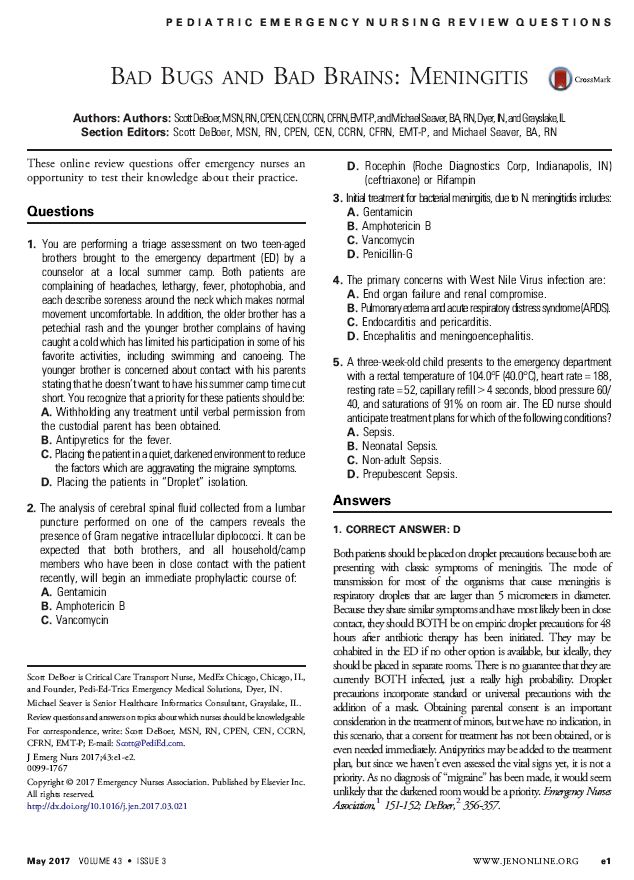
Bad Bugs and Bad Brains
Meningitis
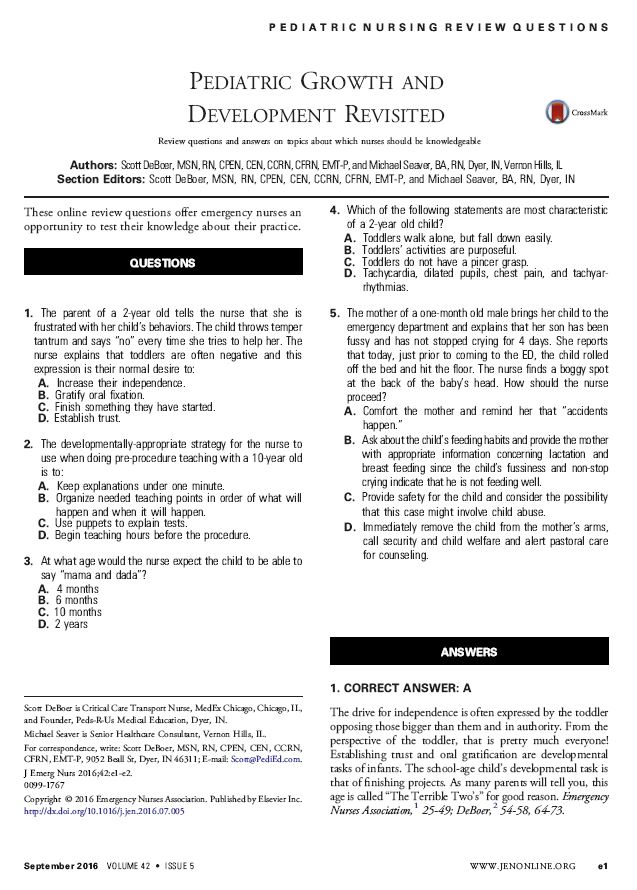
Pediatric Growth
And Development
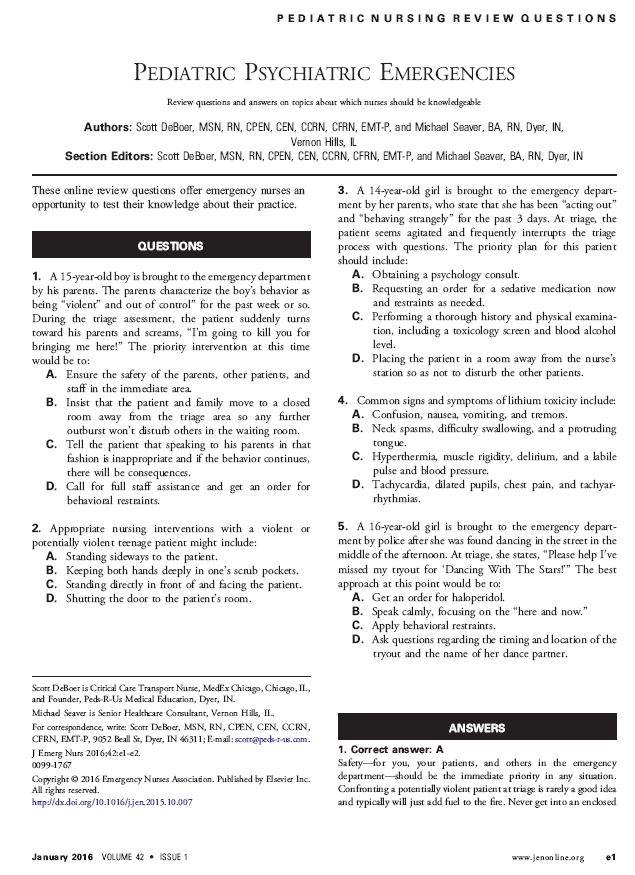
Pediatric Psych
Emergencies

The Who, What, Where, When and How
Understanding the options between the BVM and the ETT
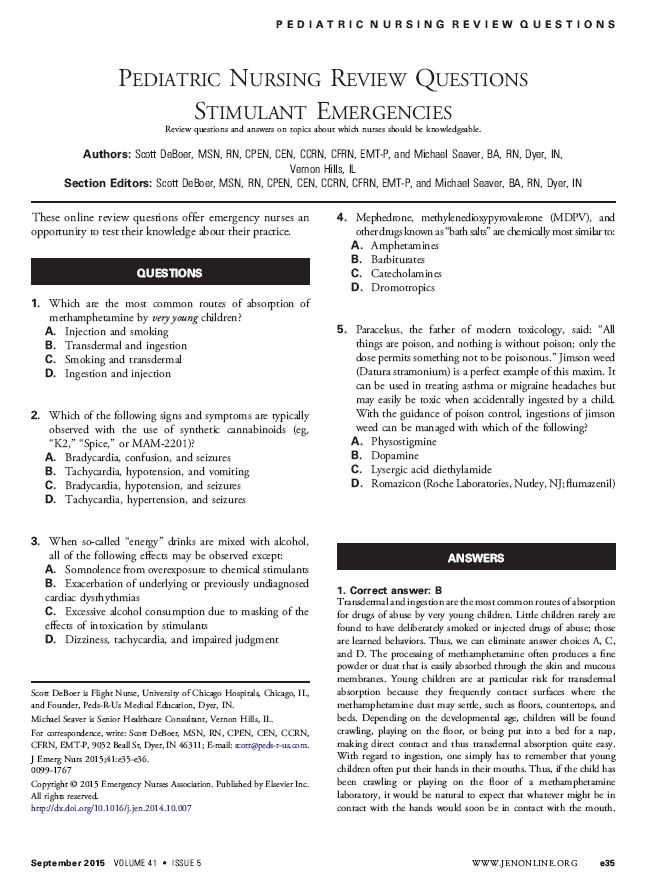
Pediatric
Stimulant Emergencies
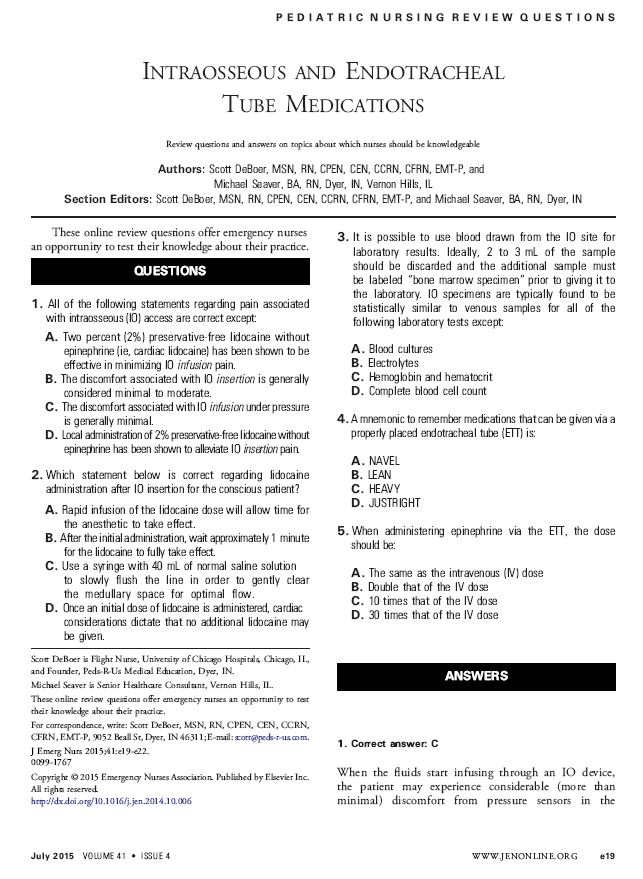
Pediatric
Resuscitation
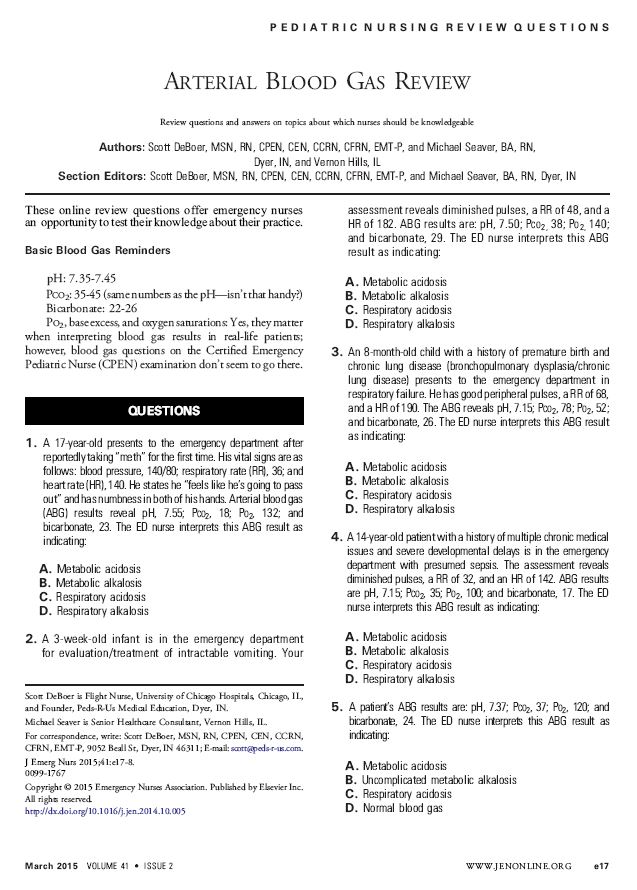
Arterial Blood
Gas Review

Pediatric Toxicology
Emergencies
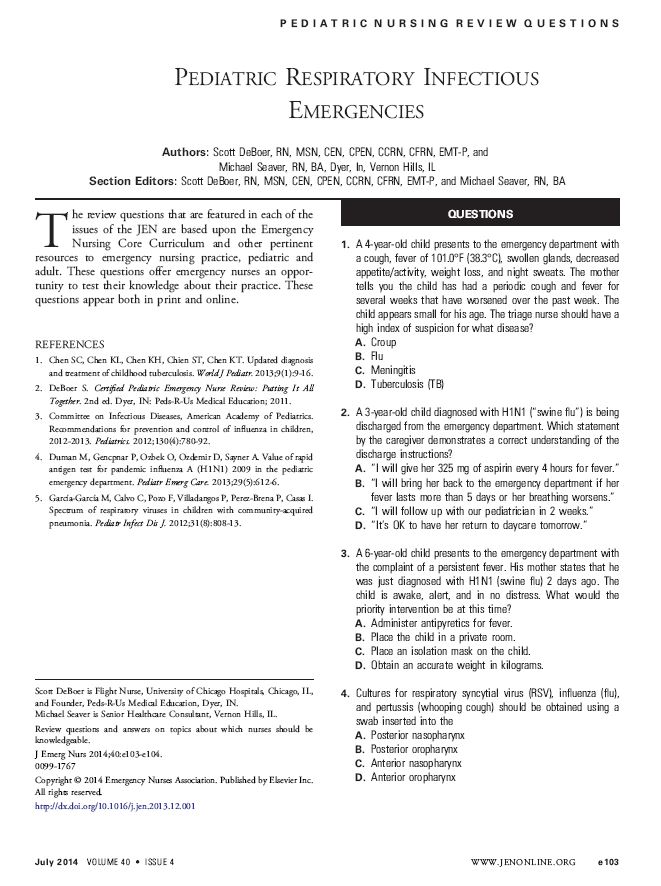
Pediatric Respiratory
Infectious Emergencies
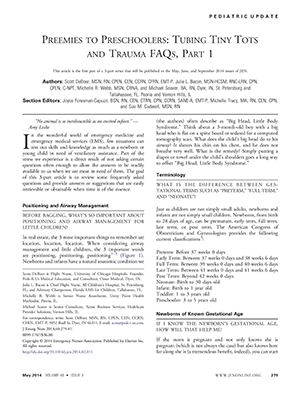
In the wonderful world of emergency medicine and emergency medical services (EMS), few situations can test our skills and knowledge as much as a newborn or young child in need of ventilatory assistance. Part of the stress we experience is a direct result of not asking certain questions often enough to allow the answers to be readily available to us when we are most in need of them...
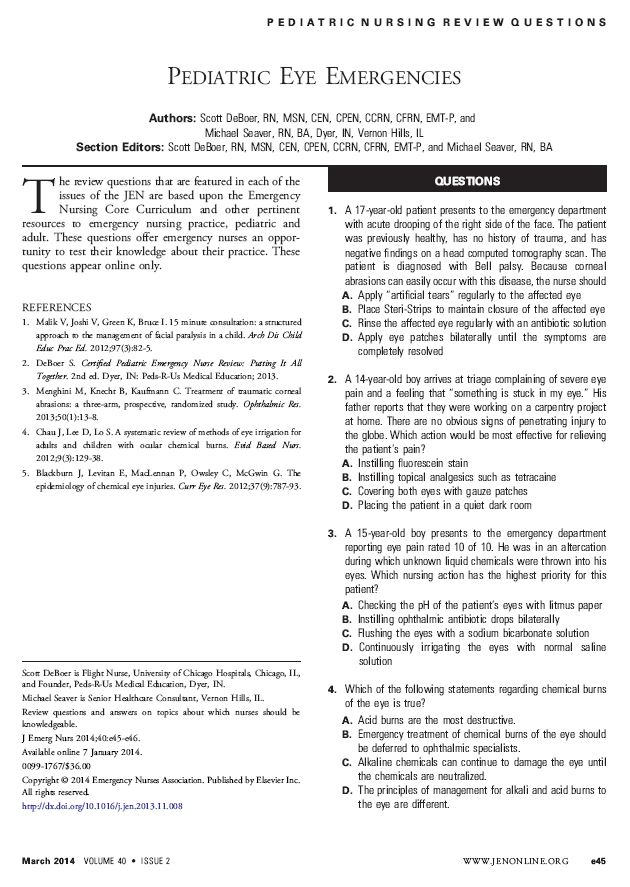
Pediatric Eye
Emergencies
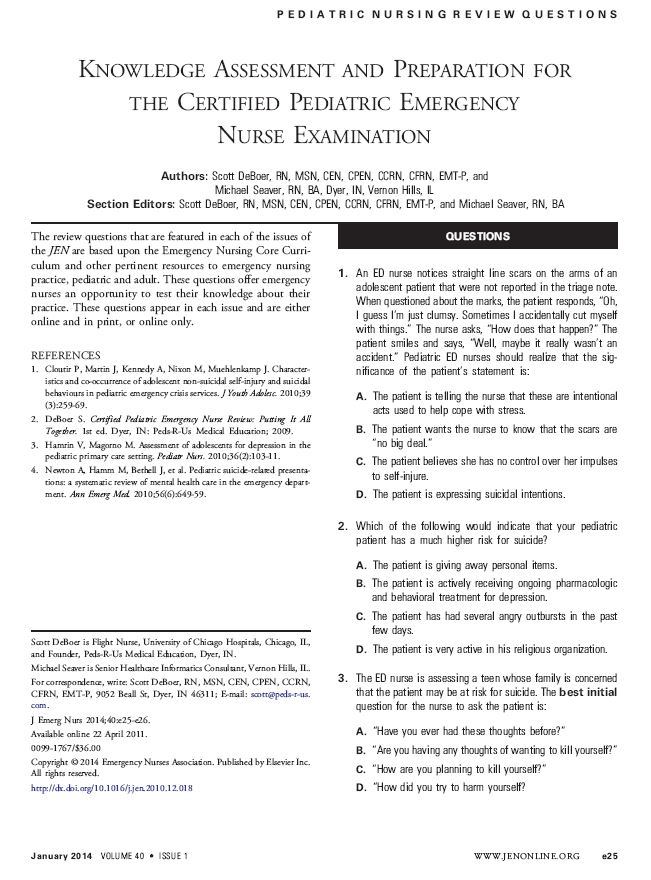
Pediatric Suicide
Emergencies

Endocrine
Emergencies
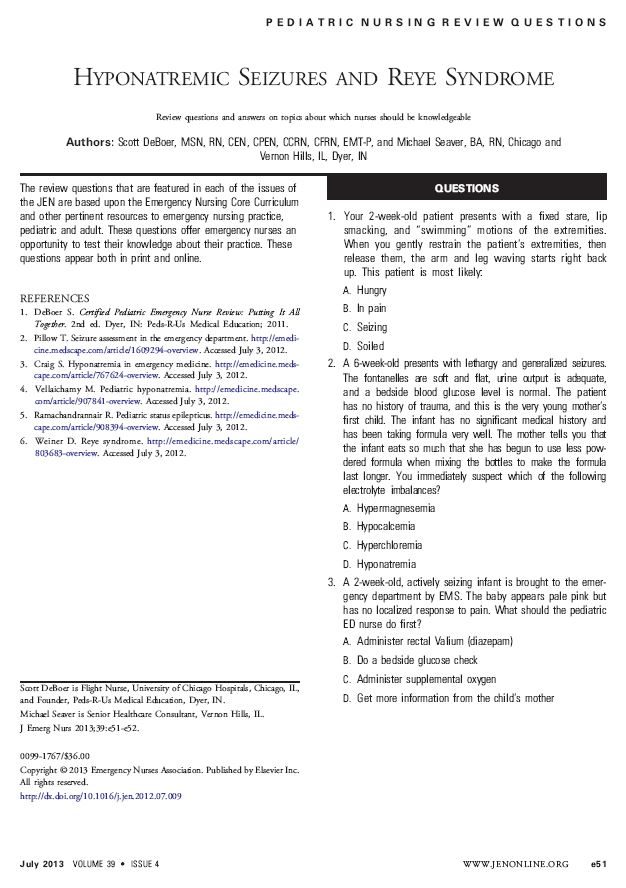
Hyponatremic Seizures
and Reye Syndrome
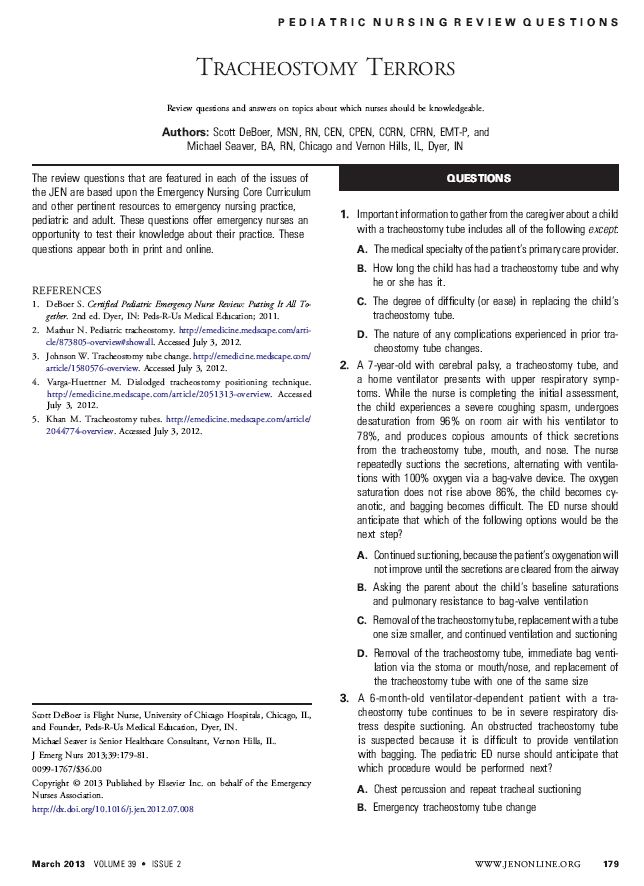
Tracheostomy Terrors
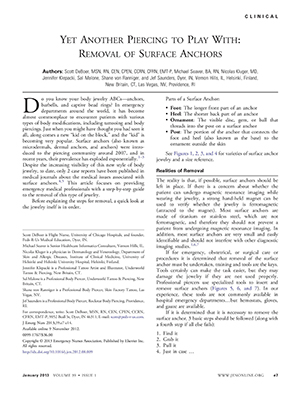
Do you know your body jewelry ABCs—anchors, barbells, and captive bead rings? In emergency departments around the world, it has become almost commonplace to encounter patients with various types of body modifications, including tattooing and body piercings. Just when you might have thought you had seen it all, along comes a new “kid on the block"...
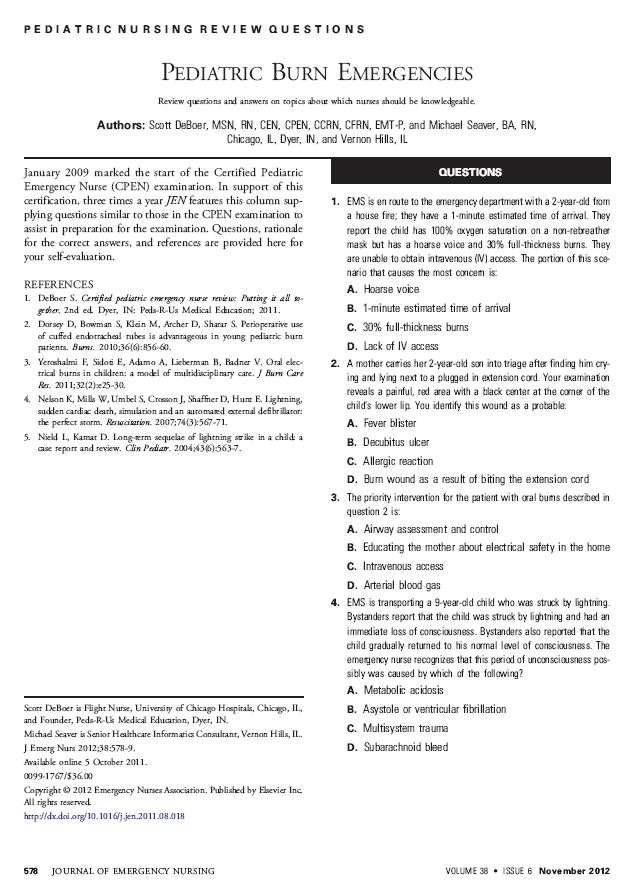
Pediatric
Burn Emergencies
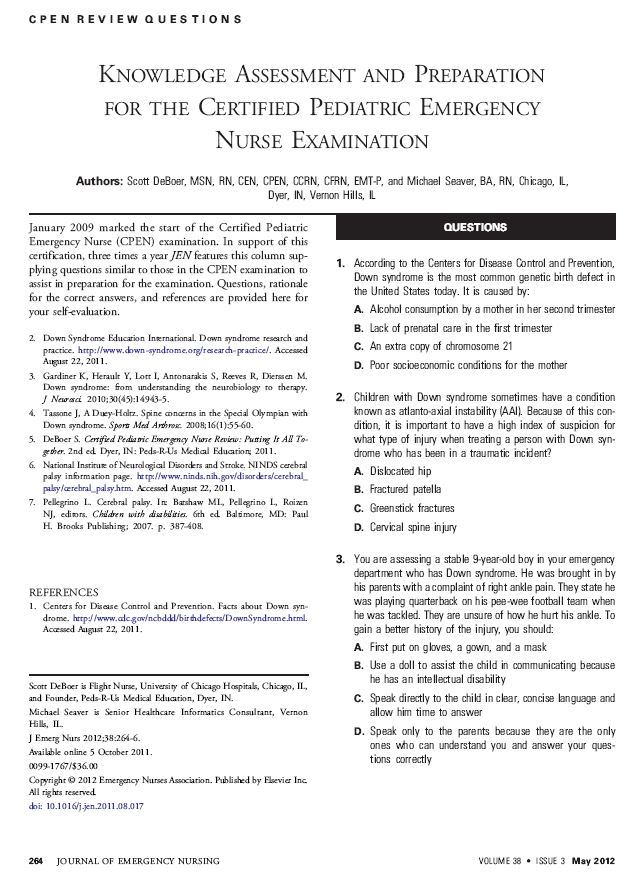
Down Syndrome
And CPQnA
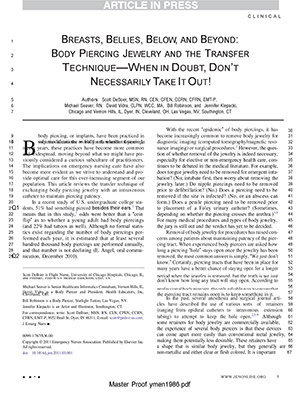
Body modifications or body art, whether tattooing,body piercing,or implants, have been practiced in become increasingly common to remove body jewelry for...
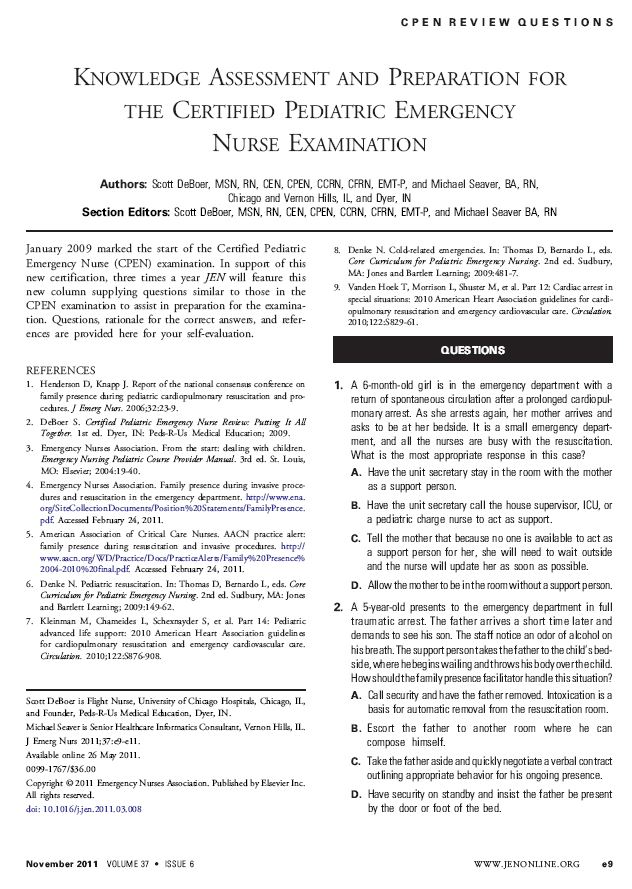
Pediatric
Resuscitation
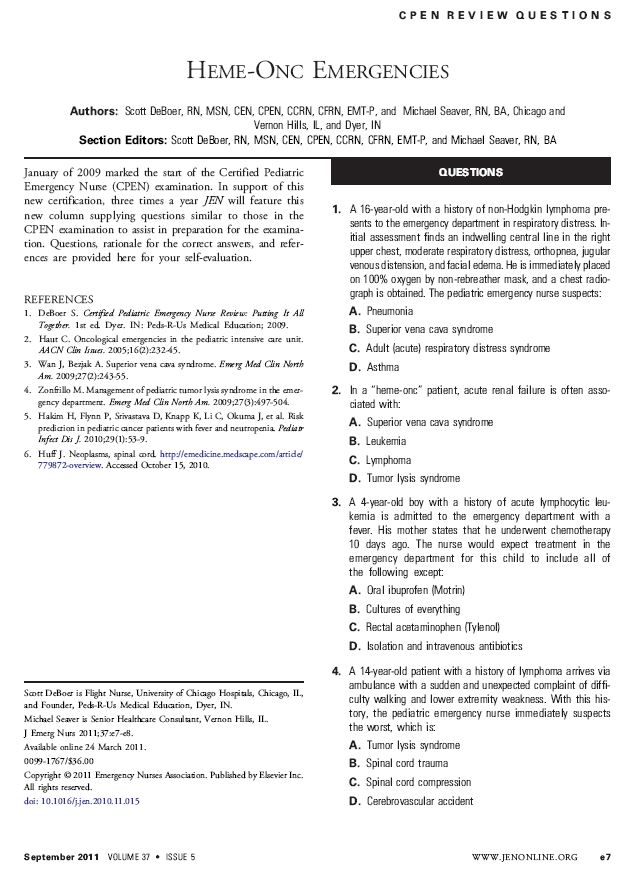
Heme-Onc
Emergencies
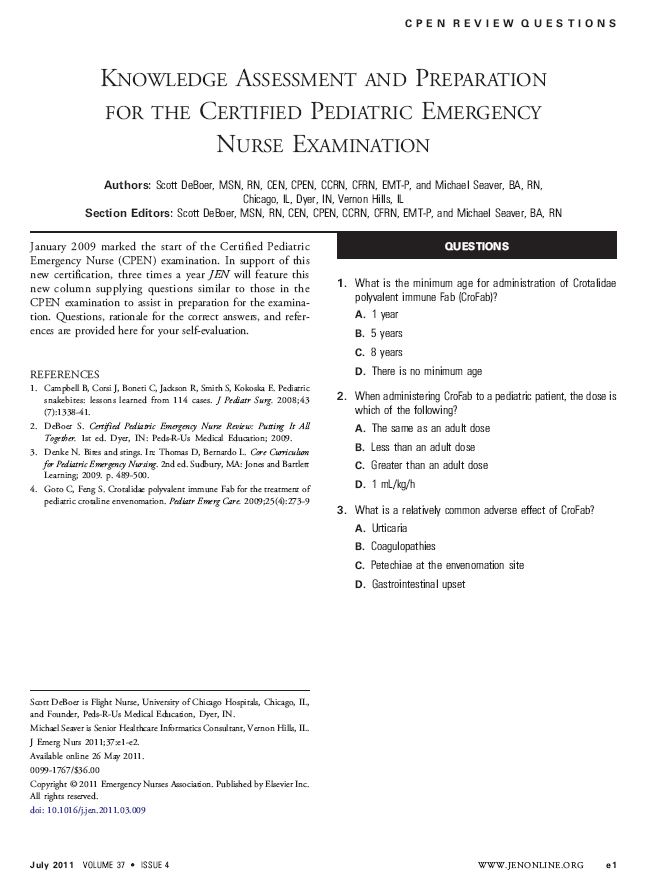
Pediatric Snake Bites
And CroFab QnA
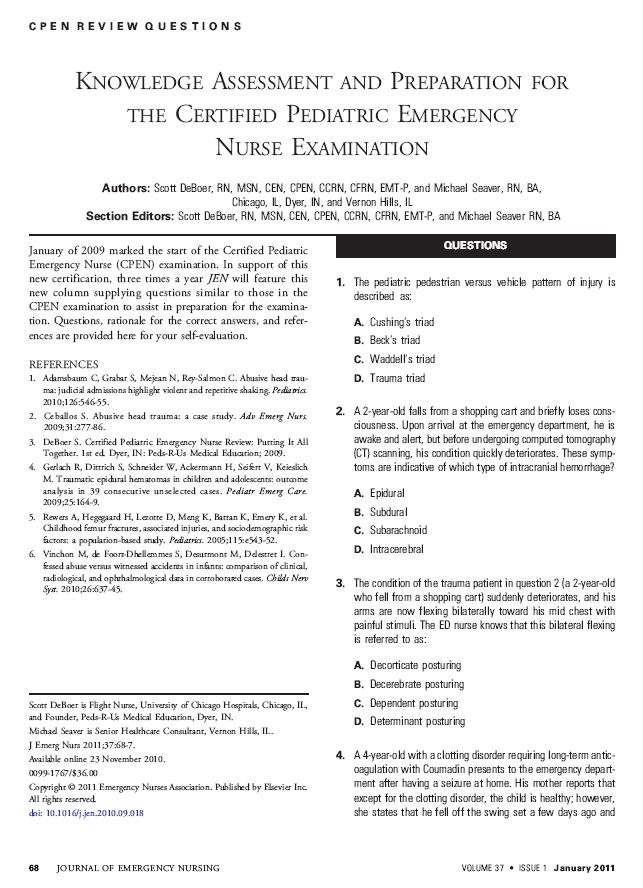
Pediatric Neuro
Emergencies
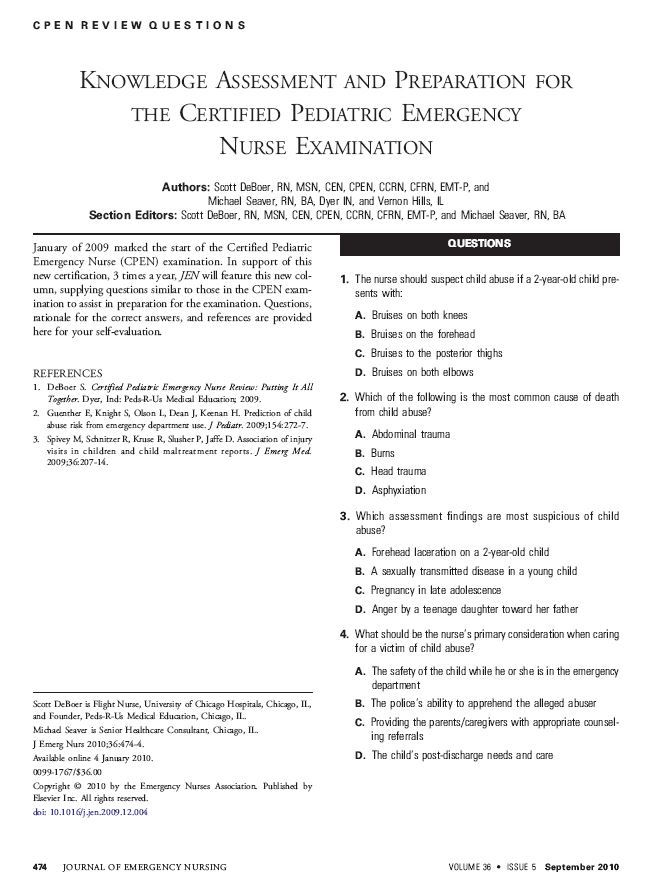
Abuse
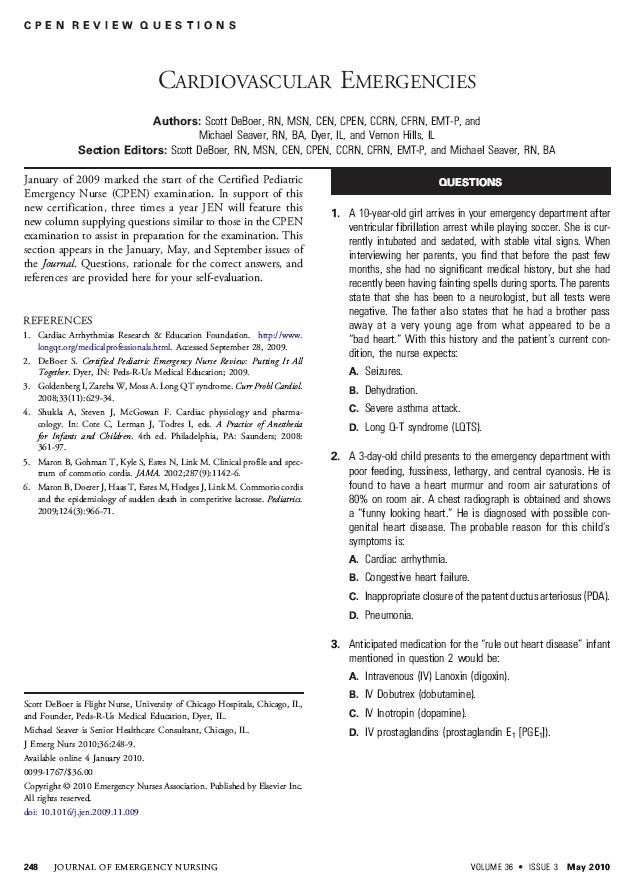
Pediatric Cardiovascular
Emergenices
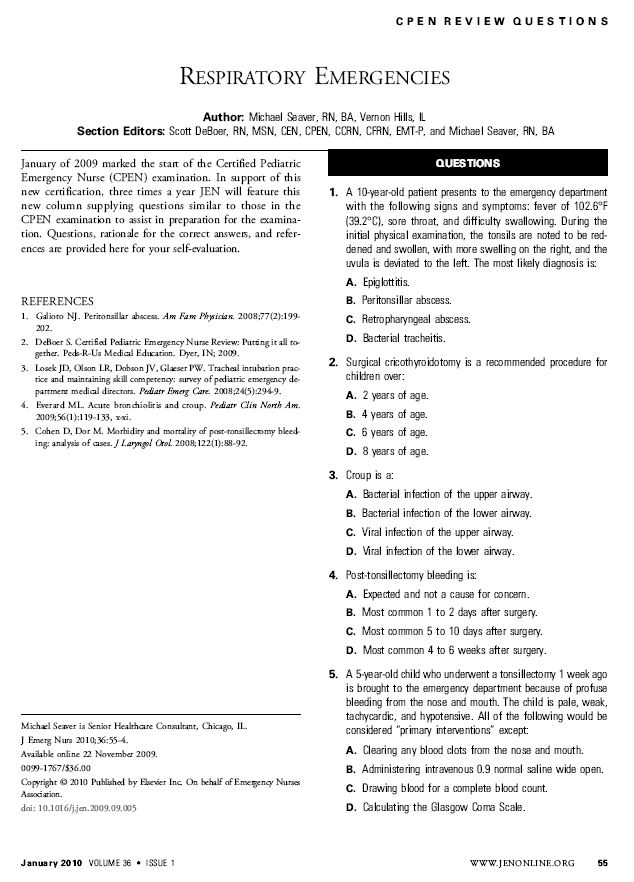
Respiratory
Emergencies
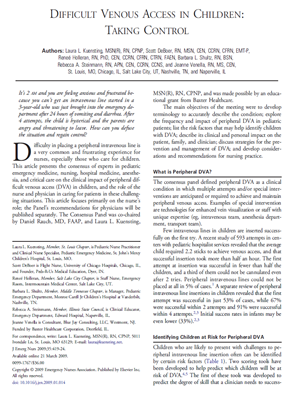
Difficult Venous Access in Children
Taking Control
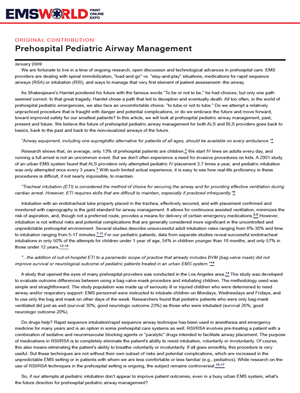
Prehospital Pediatric Airway Management

Can a patient with a tattoo safely have an MRI? The answer to this and other piercing questions...
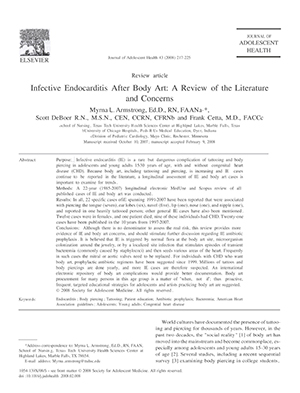
World cultures have documented the presence of tattooing and piercing for thousands of years. However, in the past two decades, the "social reality" [1] of body art has moved into the mainstream and become commonplace, especially among adolescents and young adults 15-30 years of age [2]. Several studies, including a recent sequential survey [3]examining body piercing in college studentshave documented prevalency rates of 33% to 51% since 2002...
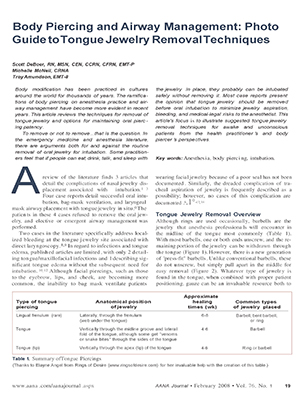
Body modification has been practiced in cultures around the world for thousands of years. The ramifications of body piercing on anesthesia practice and airway management have become more evident in recent years. This article reviews the techniques for removal of tongue jewelry and options for maintaining oral piercing patency...
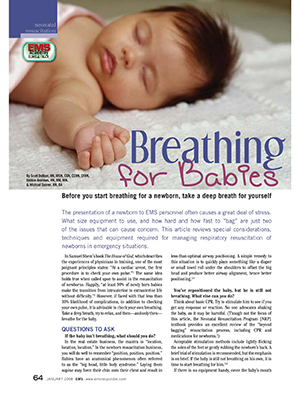
The presentation of a newborn to EMS personnel often causes a great deal of stress. What size equipment to use, and how hard and how fast to “bag” are just two of the issues that can cause concern. This article reviews special considerations, techniques and equipment required for managing respiratory resuscitation of newborns in emergency situations...
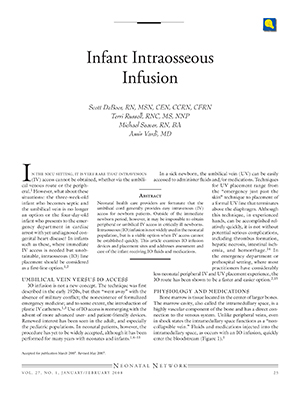
In the NICU Setting, it is very rare that intravenous (IV) access cannot be obtained, whether via the umbilical venous route or the peripheral. However, what about these situations: the three-week-old infant who becomes septic and the umbilical vein is no longer an option or the four-day-old infant who presents to the emergency department in cardiac arrest with yet undiagnosed congenital heart disease?...
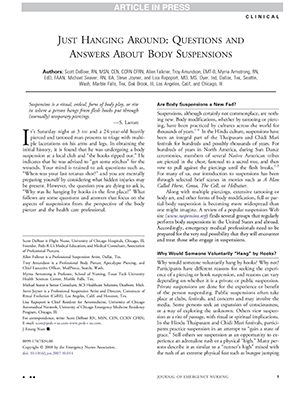
It’s Saturday night at 3 AM and a 24-year-old heavily pierced and tattooed man presents to triage with multiple lacerations on his arms and legs. In obtaining the initial history, it is found that he was undergoing a body suspension at a local club and “the hooks ripped out.”
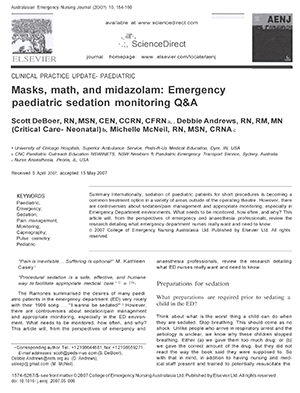
Internationally, sedation of paediatric patients for short procedures is becoming a common treatment option in a variety of areas outside of the operating theatre . However, there are controversies about sedation/pain management and appropriate monitoring, especially in Emergency Department environments. What needs to be monitored , how often , and why?...
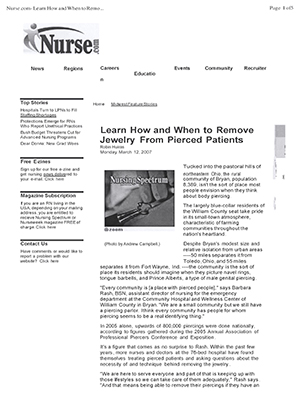
Tucked into the pastoral hills of northeastern Ohio, the rural community of Bryan, population 8,389, isn't the sort of place most people envision when they think about body piercing. The largely blue-collar residents of the William County seat take pride in its small-town atmosphere, characteristic of farming communities throughout the nation's heartland...
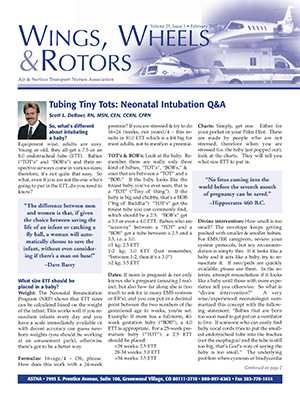
Equipment wise, adults are easy. Young or old, they all get a 7.5 or an 8.0 endotracheal tube (ETT). Babies (“TOT’s” and “BOB’s”) and their respective airways come in various sizes; therefore, it’s not quite that easy...
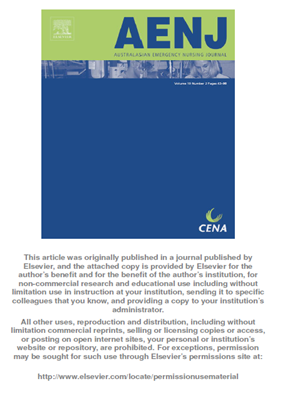
Inquiring minds want to know . . . Body piercing and modifications
Suggested resources for emergency professionals
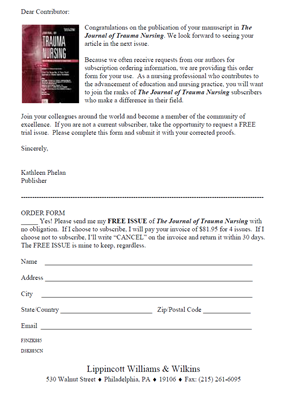
Body Piercing/Tattooing and Trauma Diagnostic Imaging
Medical Myths vs Realities
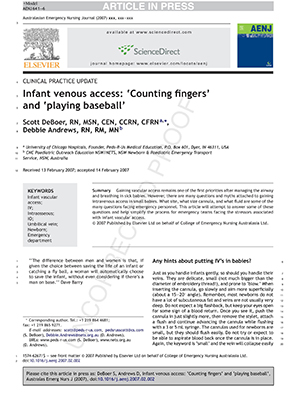
Just as you handle infants gently, so should you handle their veins. They are delicate, small (not much bigger than the diameter of embroidery thread!), and prone to ‘blow.’ When inserting the cannula, go slowly and...
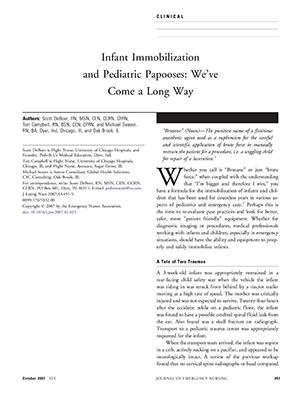
Whether you call it ‘‘Brutane’’ or just ‘‘brute force,’’ when coupled with the understanding that ‘‘I’m bigger and therefore I win,’’ you have a formula for the immobilization of infants and children that has been used for countless years in various aspects of pediatrics and emergency care. Perhaps this is the time to re-evaluate past practices and look for better, safer, more ‘‘patient friendly’’ equipment...
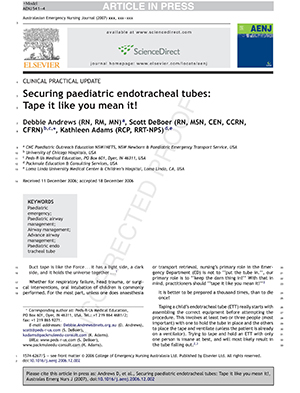
Duct tape is like the Force... it has a light side, a dark side, and it holds the universe together... Whether for respiratory failure, head trauma, or surgical interventions, oral intubation of children is commonly performed. For the most part, unless one does anaesthesia...

Tongues, Tubes, and Teens
Body Piercing and Airway Management

In 2005, The Association of Professional Piercers has their annual meeting with about 800 attendees who claim to preform on average 1,000 piercings per year...
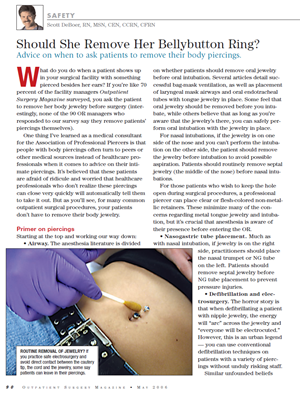
Should She Remove Her Bellybutton Ring?
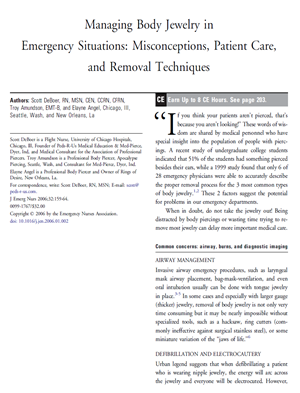
Managing Body Jewelry in Emergency Situations
Misconceptions, Patient Care, and Removal Techniques

Professional piercer on call
It’s time has come?

In the world of health care there is now yet another language to understand: that of body piercing. A 2002 study regarding body piercing of undergraduate students...revealed that 51% of students had something pierced "beyond their ears."...
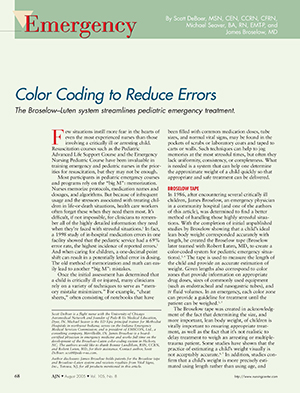
Few situations instill more fear in the hearts of even the most experienced nurses than those involving a critically ill or arresting child. Resuscitation courses such as the Pediatric Advanced Life Support Course and the Emergency Nursing Pediatric Course have been invaluable in training emergency and pediatric nurses in the priorities for resuscitation, but they may not be enough...

When most emergency medical caregivers are asked about the type of patients who truly inspire fear, more often than not, the answer is ‘‘children’’. Why is there this inverse relationship between the age of the patient and the caregiver’s level of anxiety? Perhaps the answer to this question is...
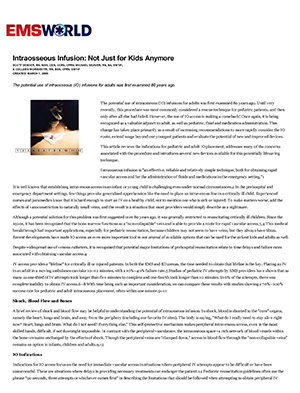
The potential use of intraosseous (IO) infusions for adults was first examined 80 years ago. Until very recently, this procedure was most commonly considered a rescue technique for pediatric patients, and then only after all else had failed. However, the use of IO access is making a comeback!...
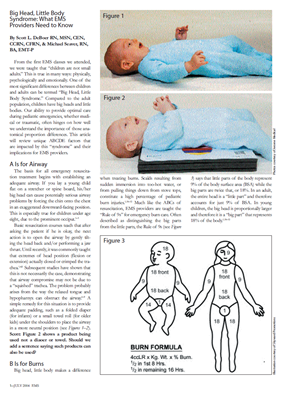
Big Head, Little Body Syndrome
What EMS Providers Need to Know
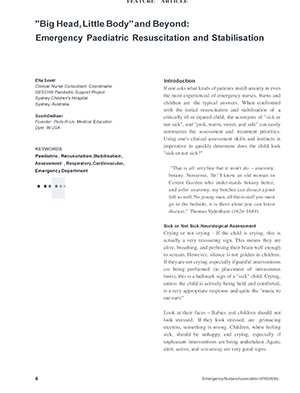
If one asks what kinds of patients in still anxiety in even the most experienced of emergency nurses, burns and children are the typical answers. When confronted with the initial resuscitation and stabilisation of a critically ill or injured child, the acronyms of "sick or not sick", and "pink, warm,sweet, and safe" can easily summarize...
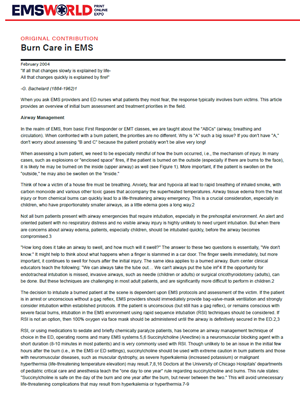
Burn Care in EMS
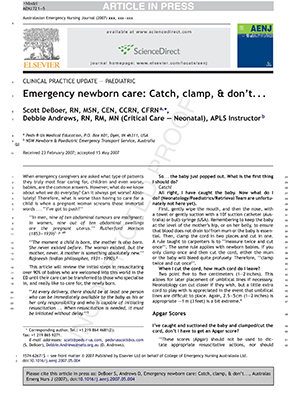
When emergency caregivers are asked what type of patients they truly most fear caring for, children and even worse, babies, are the common answers. However, what do we know about what we do everyday? Can it always get worse? Absolutely! Therefore, what is worse than having to care for a child is when a pregnant woman screams those immortal words...‘‘I’ve got to push!’...
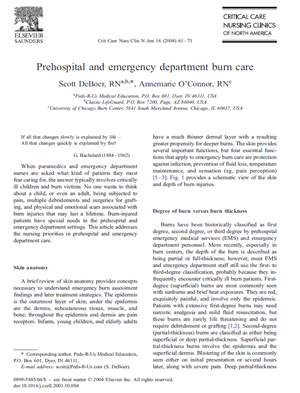
Prehospital and emergency department burn care
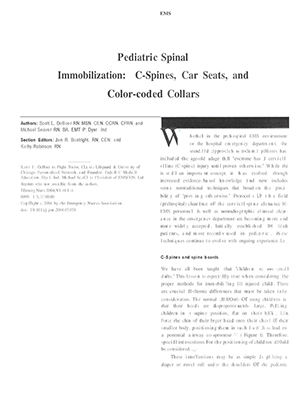
Whether in the prehospital EMS environment or the hospital emergency department the standard approach to Hienrs has included the age-old phrase "everyone has a cervical spine (C-spines) injury until proven otherwise."...

Endotracheal tubes are misplaced more ofter than one may think, and the consequences of not quickly detecting and correcting the error can be catastrophic...
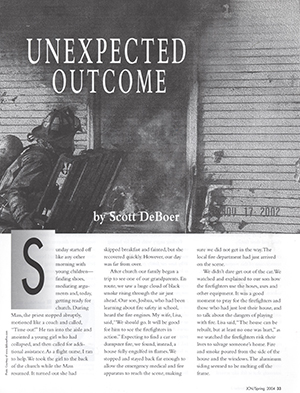
Sunday started off like any other morning with young children- finding shoes, mediating arguments and, today, church. During the Mass, the priest stopped abruptly...
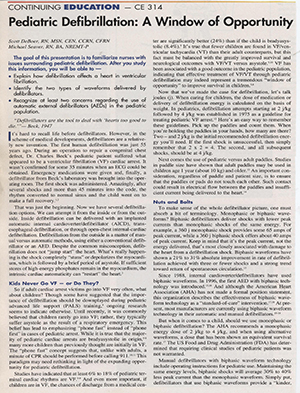
It's hard to recall life before difibrillators. However, in the scheme of medical developments, defibrillators are a realtively new invention...
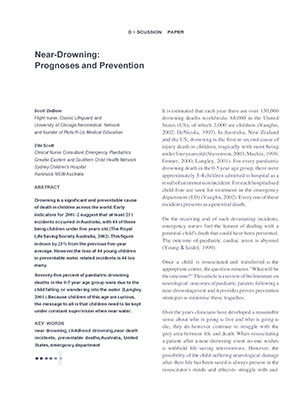
Drowning is a significant and preventable cause of death in children across the world. Early indicators for 2001-2 suggest that at least 251 incidents occurred in Australia, with 44 of these being children under five years old...
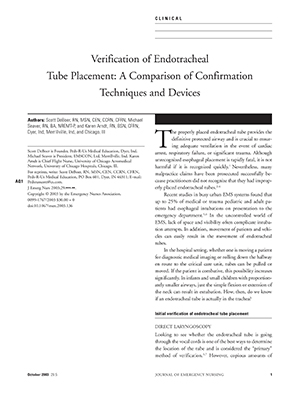
The properly placed endotracheal tube provides the definitive protected airway and is crucial to ensuring adequate ventilation in the event of cardiac arrest, respiratory failure, or significant trauma. Although unrecognized esophageal placement is rapidly fatal, it is not harmful if it is recognized quickly...
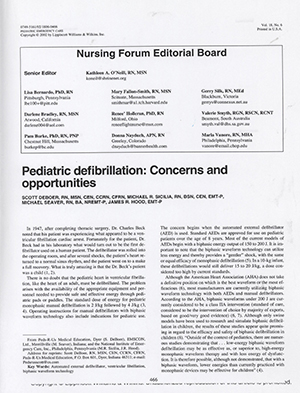
In 1947, after completing thoracic surgery, Dr. Charles Beck noted that his patient was experiencing what appeared to be a ventricular fibrillation cardic arrest. Fortunately for the patient, Dr. Beck had in his laboratory what would turn out to be the first defibrillator used on a human patient...
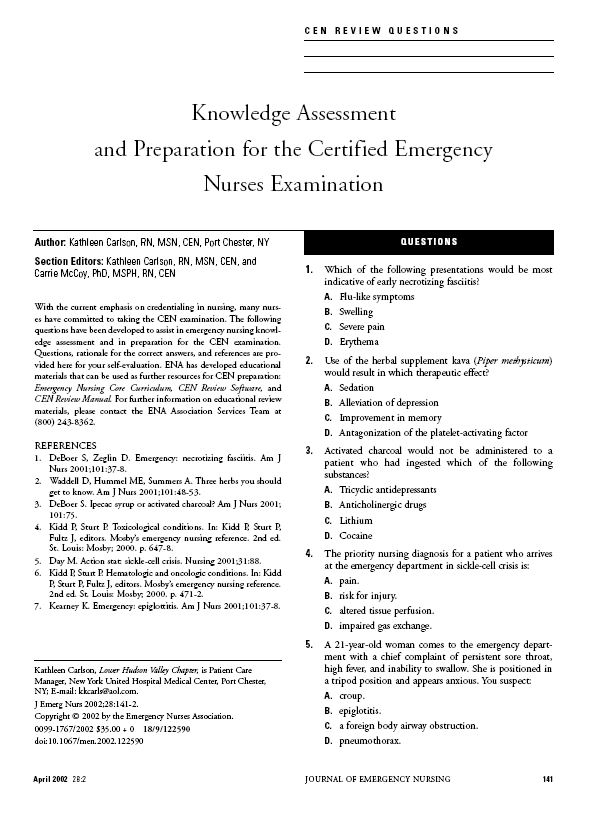
Miscellaneous
Medical Emergencies
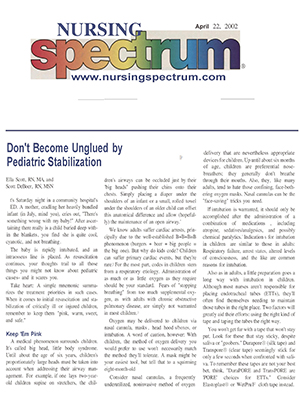
It's Saturday night in a community hospital's ED. A mother, cradling her heavily bundled infant(in July, mind you), cries out, "There's something wrong with my baby!"...
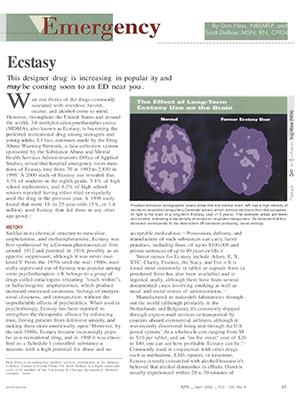
When one thinks of the drugs commonly associated with overdose, heroin, cocaine, and alcohol come to mind. However,throughout the United States and around the world, methylenedioxymethamphetamine (MDMA), also known as Ecstasy,is becoming the preferred recreational drug among teenagers and young adults...
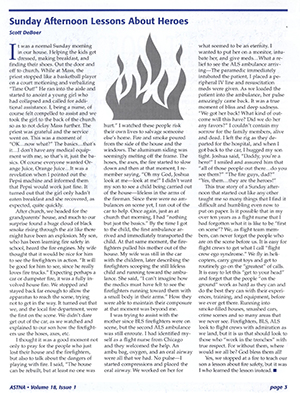
It was a normal Sunday morning in our house. Helping the kids get dressed, making breakfest, and finding their shoes. Out the door and off the church. While at Mass, the priest stopped...
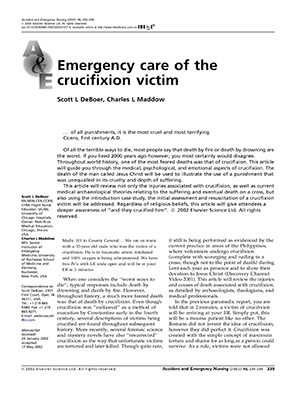
Of all the terrible ways to die, most people say that death by fire or death by drowning are the worst. If you lived 2000 years ago however, you most certainly would disagree...
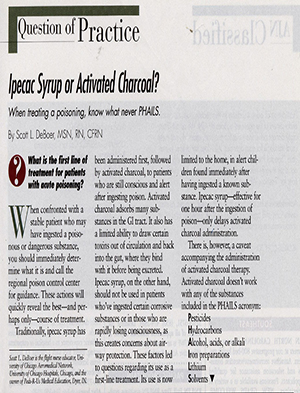
When confronted with a stable patient who may have ingested a poisonous or dangerous substance, you should immediately determine what it is and call the regional poison control center for guidance. These actions will quickly reveal the best - and perhaps only- course of treatment.
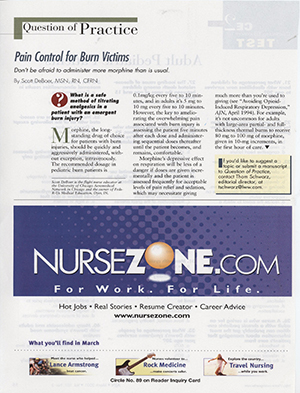
Morphine, the long-standing drug of choice for patients with burn injuries, should be quickly and aggressively administered, without exception, intravenously...

“We believe in one God. . . . He suffered, died, and was buried . . .” Each week, Catholics profess this truth, but do we really think about what we just said? When we think of crucifixion, we usually think of the physical nailing to the cross. However, the nails were just a small part of the “the utterly vile death of the cross.”...
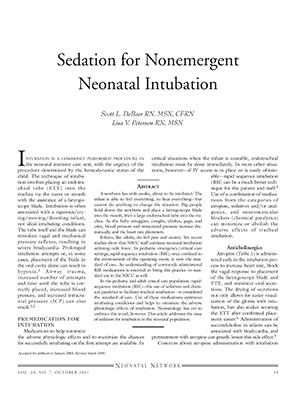
Intubation is a commonly performed procedure in the neonatal intensive care unit, with the urgency of the procedure determined by the hemodynamic status of the child. The technique of intubation involves placing an endotracheal tube (ETT)...
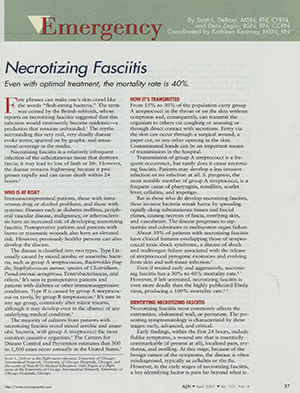
Few phrases can make one's skin crawl like the words "flesh-eating bacteria." The term was coined by the British tabloids, whose reports on necrotizing fasciitis suggested that this infection would imminently become epidemic...
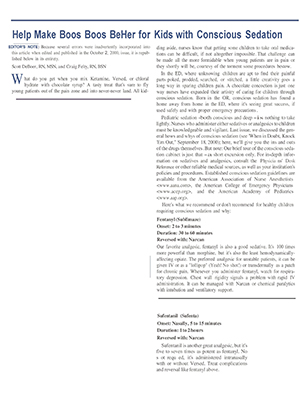
What do you get when you mix Ketamine, Versed, or chloralhydrate with chocolate syrup? A tasty treat that's sure to fly young patients out of the pain zone and into never-never land. All kidding aside, nurses know that getting some children to take oral medications can be difficult, if not altogether impossible...
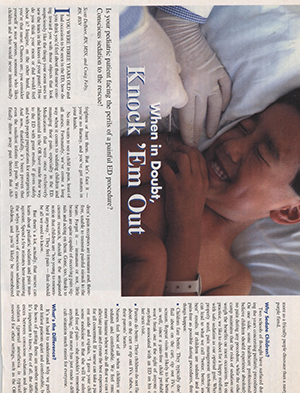
If you were three years old and has occasion to be seen by the ED, how do you think you'd feel about that nurse coming toward you with those objects that look suspiciously like the things your mom uses to sew the tears in the knees of your pants...
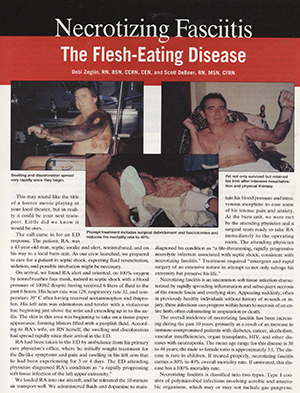
This may sound like the title of a horror movie playing at your local theater, but in reality it could be your next transport. Little did we know it would be ours...
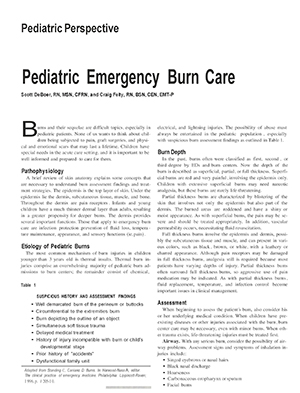
Burns and their sequelae are difficult topics, especially in pediatric patients. None of us wants to think about children being subjected to pain, graft surgeries, and physical and emotional scars that may last a lifetime...
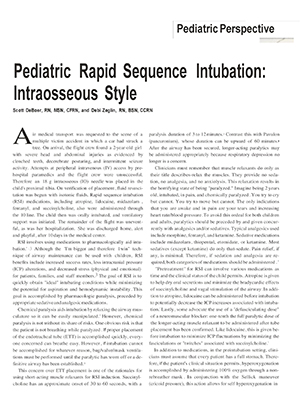
Air medical transport was requested to the scene of a multiple victim accident in which a car had struck a tree. On arrival, the flight crew found a 2-year-old girl with severe head and abdominal injuries as evidenced by clenched teeth, decerebrate posturing, and intermittent seizure activity...
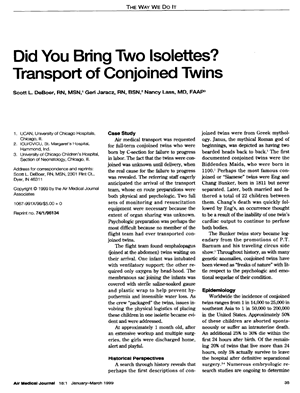
Did You Bring Two Isolettes?
Transport of Conjoined Twins

If you could choose how you were going to die, what method would you pick? Most people say they would like to "pass away in their sleep" or "go to bed and never wake up" and why not? It's quick, easy, and, most importantly, painless...

A conflict arises between the desire to avoid resuscitating patients who will live only to exist in a persistent vegetative state and the desire to avoid denying even a small number of patients a chance for meaningful survival and recovery...

Pulmonary hypertension, though quite normal in the fetus while burden of oxygenation is on the maternal placenta, can be rapidly fatal if severe resistance to pulmonary blood flow continues as the infant attempts to make the transition to extrauterine life...
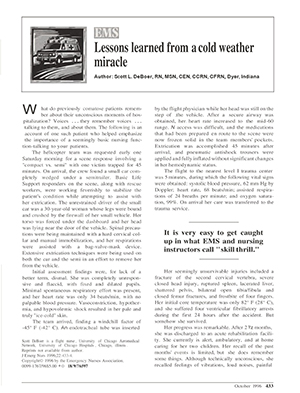
What do previously comatose patients remember about their unconscious moments of hospitalization? Voices ... they remember voices... talking to them, and about them. The following is an account of one such patient who helped emphasize the importance of a seemingly basic nursing function - talking to your patients...
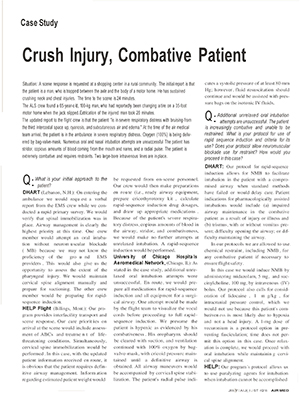
Situation:A scene response is requested at a shopping center in a rural community. The initial report is that the patient is a man, who is trapped between the axle and the body of a motor home. He has sustained crushing neck and chest injuries. The time to the scene is 24 minutes...
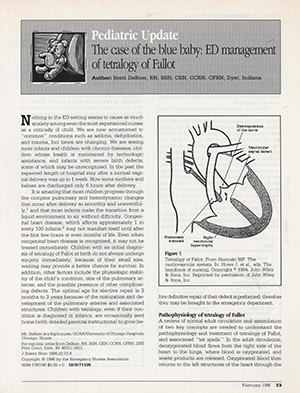
Nothing in the ED setting seems to cause as much anxiety among even the most experienced nurses as a critically ill child. We are now accustomed to "common" conditions such as asthma, dehydration, and trauma, but times are changing...
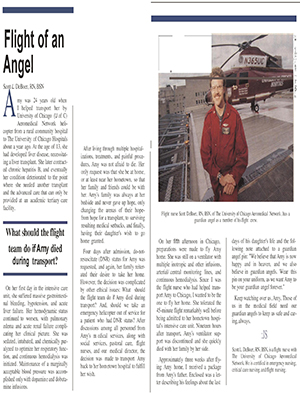
Amy was 24 years old when I helped transport her by University of Chicago (U of C) Aeromedical Network helicopter from a rural community hospital to The University of Chicago Hospitals about a year ago. At the age of 13, she had developed liver disease...